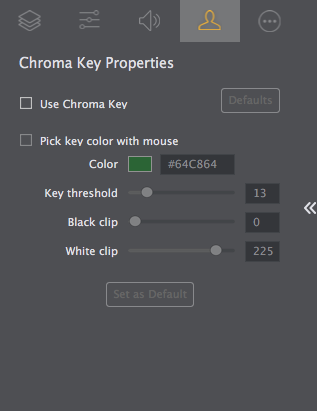

This helps minimize spill and unwanted shadows appearing on the green screen background. Keep your subject at least six feet away from the green screen. Separate Your Subject from the Background


blue screen debate to determine which color is right for your shoot. Use a non-reflective green screen material and look for colors such as “chroma key green” and “digi green.” These colors are toned to be ideal for use with green screens.Īlternatively, blue screens can also be used, especially for replicating night scenes. If you’re looking for the TLDR of green screens, we’ve picked out six essential rules that will set a good foundation for your next chroma key project. We know you’re busy, and we know this article is long. You can take several steps to prevent spills, which we’ll discuss below. This can cause an issue in the keying stage. When a green screen is brightly lit, the light can reflect that color back onto your subject, casting unwanted green light. Spill: This often refers to the colored light that reflects back onto your subject from the green screen. The goal is to get the cleanest key possible, meaning no digital artifacts are left on your image where the green screen initially appears. Then you can fill in that transparent area with a different image or video. When the green screen background has been keyed, it’ll be fully transparent. Keying: This term describes removing the green screen background in post-production using video editing software. Every color has a chroma range, hence where the terminology comes from. It’s the actual technique of layering or compositing two images based on color hues. (Blue screens were frequently used in the early days with film and might still be used in some instances.) Sometimes the term is used as a fit-all for the entire keying process (see below).Ĭhroma Key: This popular term goes hand-in-hand with green screen.
CHROMA KEY LIVE PREVIEW SKIN
This is usually a single-colored backdrop, which can be any color, but is generally bright green because it’s the color furthest away from human skin tones. Green Screen: Technically, this term refers to the colored background you want to make transparent and remove from your shot.
CHROMA KEY LIVE PREVIEW HOW TO
What Is Green Screen and Chroma Keying? Image via Disney+.īefore we jump into how to use a green screen, let’s learn what a green screen does and familiarize ourselves with a few key terms. We’ll talk about lighting, cinematography, keying, editing, and common mistakes. Here, we’ll guide you through the entire process of using green screen backgrounds from start to finish. Many of your favorite YouTubers utilize technology that was once reserved solely for Hollywood blockbusters. The use of green screens has come a long way over the past few decades. You’ll find that really good green (and blue) screen comes in many packages, from David Fincher‘s subtle yet detail-oriented effects to the iconic space battles in Star Wars. You can peruse YouTube for behind-the-scenes clips or check out our round-up of the most inventive uses of green screen throughout the years. One of the best ways to learn about green screen is to research how it’s been implemented in actual movies. From Marvel movies to local news stations, everyone’s got the key (hah!) to expert compositing technology. While that’s an entirely unscientific appraisal that you shouldn’t cite in a college paper, it’s probably not far off, considering the accessibility and sophistication of today’s green screen technology.
CHROMA KEY LIVE PREVIEW MOVIE
In our estimate, almost every big movie made in 2019 used green screen effects for at least one scene. Video scopes would be crazy helpful in pulling better keys, so we have the data to make the key look right and help take the guesswork out of the tools.This guide will walk through everything you need to know about green screen backgrounds and achieving a perfect chroma key. Basically works like magic.įor Advanced Key, More options for selecting color ranges, edge detection, layers of key selection, shape masks to limit the effect to specific regions, luminance range selectors, selectable key views (what's keyed, what's not, etc.), Grow/Shrink, whole fill, Mask Paint (would be an awesome feature), and Video Scopes. Its super easy to select, and add to selections in order to pull a great key with Instant Alpha. Seems like there is room for 2 tools in the product (Quick Key, and Advanced Key).įor a quick key tool, I'd love to see the feature work like the Instant Alpha tool in Keynote. One issue I see many users have, especially when using low bit depth cameras such as their built in FaceTime Cameras, is not color grading the shot first. Chroma Key is a very helpful tool but really needs to be improved.


 0 kommentar(er)
0 kommentar(er)
